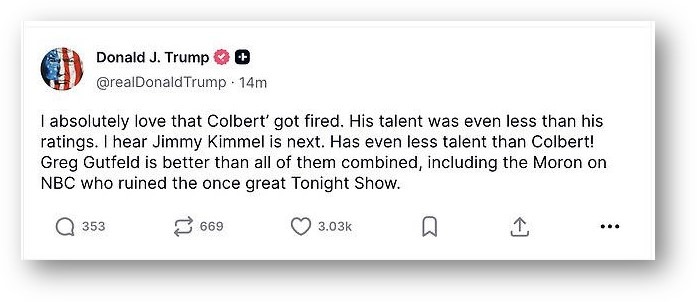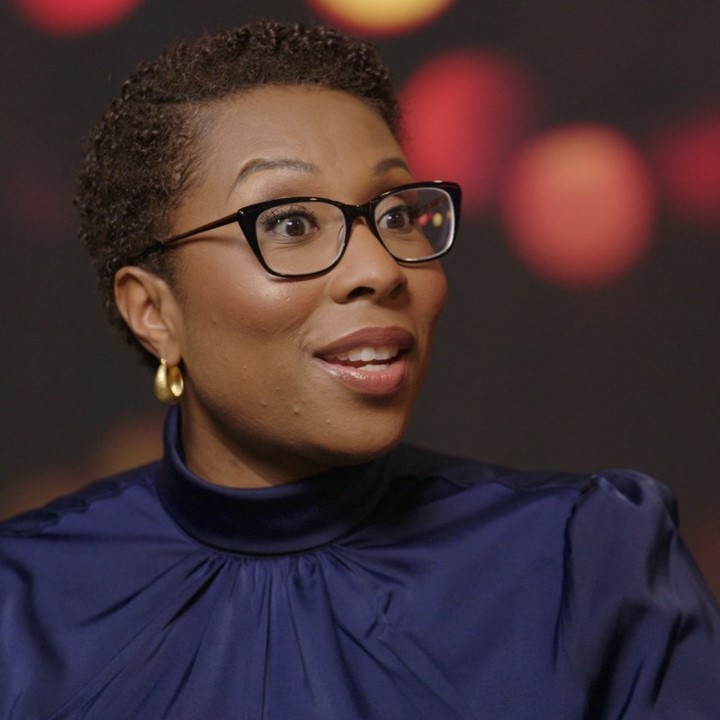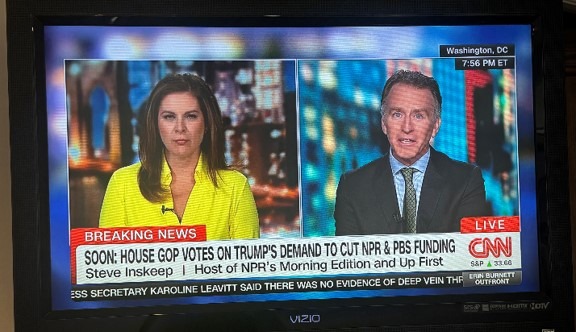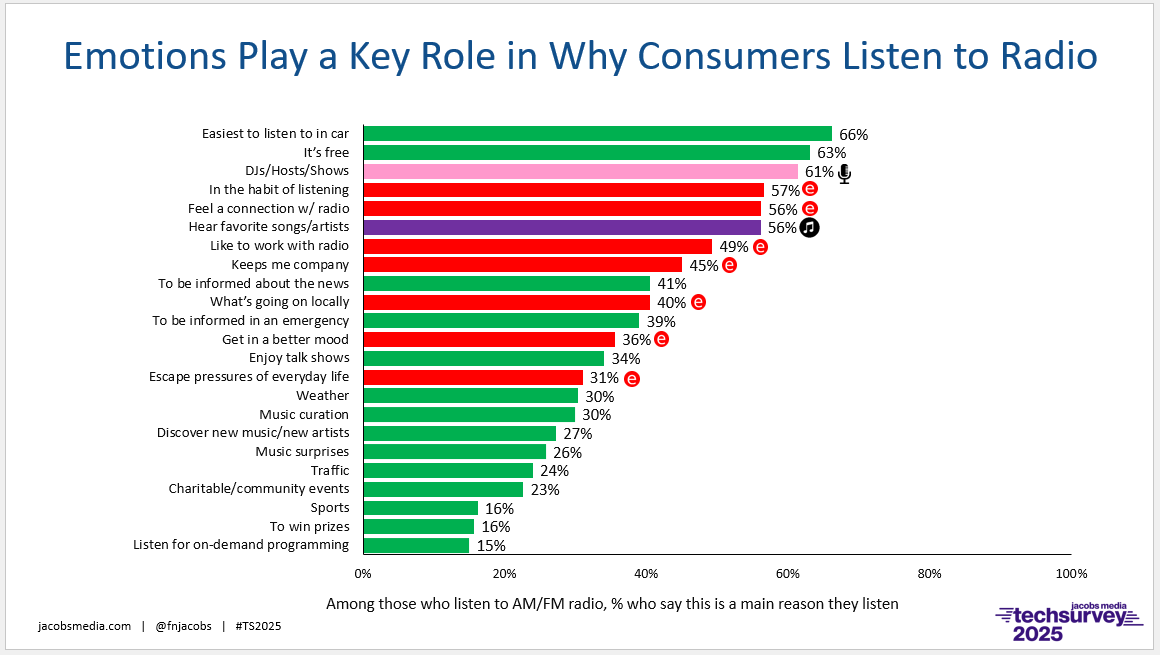
Since radio’s earliest days, personality appeal has always been a key motivator behind why people choose to listen, and why many still make radio a part of their daily routines. For all the changes that have roiled the radio business—internally and externally—it is the human being behind the mic that has served as the one constant, transcending styles and format, time, rules and regulations.
Last week ended with two “breaking news” stories that promise to be much-discussed over the next several months, if not longer. First, it was the defunding of the Corporation for Public Broadcasting which will most assuredly impact unknown numbers of stations frantically reshaping their funding models. And second, the cancellation of Stephen Colbert and the The Late Show franchise by CBS.
Each of these moves is steeped in the politics of the moment. The fact the President of the United States celebrated both of these industry-altering events goes to the heart of the changing media scene. Whatever you think of either decision—by the U.S. Congress and whoever’s running the programming department at CBS—there’s no doubt they will have a lasting effect on broadcast television and radio in this country as we’ve known it over decades and decades.
fact the President of the United States celebrated both of these industry-altering events goes to the heart of the changing media scene. Whatever you think of either decision—by the U.S. Congress and whoever’s running the programming department at CBS—there’s no doubt they will have a lasting effect on broadcast television and radio in this country as we’ve known it over decades and decades.
The Colbert ouster is already being heavily debated as to the factors that triggered deep-sixing both the host and the show. After an amazing 30+ year run on CBS starting with David Letterman, The Late Show joins a long list of great shows that apparently can no longer cut it. Even though Colbert often topped his two direct competitors in the ratings, NBC’s Jimmy Fallon and ABC’s Jimmy Kimmel, strong time-spent viewing and loyalty measures weren’t nearly enough to earn The Late Show a stay of execution much less a makeover.
Many have speculated its revenue is no longer sufficient to justify expensive late night television shows that attract mostly older viewers. While Colbert’s shares were solid up against his two competitors, overall viewing has been on the decline—a problem radio execs know too well.
In fact, CNN’s Brian Stelter reported last night that aggregate revenue for Colbert, Fallon, and Kimmel fell from $439 million in 2018 to $220 million last year—a drop of 50%. The story reports CBS execs were at an impasse over how to turn The Late Show‘s financial fortunes around.
Of course, rumors are swirling that the axing of Colbert and Late Night were a sinister condition of the pending merger between CBS’s parent, Paramount, with Skydance Media by the outspoken occupant of the White House. Colbert has been a constant critic of Trump, only adding fuel to the fire that his firing was all part of a sinister, even conspiratorial deal. When was the last time the President of the United States celebrated the RIFing of a popular TV host, along with his two direct competitors? That’s right, it’s unprecedented.

Speaking of unprecedented, the big story on the public media side was frankly not as impactful, newsworthy, or viral. Part of the reason might be the always-hot news cycle that has the potential for any story, especially regarding low-key operations like public radio and TV stations. And between Colbert and yet another Jeffrey Epstein resurrection. How can a news story about clawing back Congressional funding hope to compete against the constant drumbeat of news from the White House and around the world?
For public radio and TV stations, the goings-on have been nothing short of surreal, to say the least. Most employees of these stations have been on an emotional roller coaster, alternating between feelings of defiance and anger on the one hand, to palpable fear about their future. WGBH/Boston may have summed it up in three words displayed over the weekend on their headquarters. I’m sure they spoke for many perplexed public media professionals.
feelings of defiance and anger on the one hand, to palpable fear about their future. WGBH/Boston may have summed it up in three words displayed over the weekend on their headquarters. I’m sure they spoke for many perplexed public media professionals.
Perhaps the other factor that kept public media’s financial future down the hierarchy of the news this past weekend revolves around personalities—or the lack of them, especially on public radio. When there’s a face on a station, media organization, or platform, regularly folks have common ground talking points that fuel conversations on social media and in work and social settings.
While public TV has always had Big Bird as a tangible symbol of its brand, public radio has long been bereft of marketable personalities. Names like Bob Edwards, Garrison Keillor, and Click and Clack (from Car Talk) are all ghosts of public radio’s past, and remaining stars such as Terry Gross, Ira Glass, and Peter Sagal all tend to be promoted as parts or components of their shows, not the stars of them.
NPR’s most successful shows are their two newsmagazines, Morning Edition and All Things Considered, but most listeners would be hard-pressed to tell you the names of their anchors. And it has nothing to do with their talent or presence. Both shows are extremely well-done, but intentionally shy away from showcasing the journalists who anchor and report on the news. Oftentimes, these hosts and reporters seem to come and go, often defying the conventional wisdom that suggests anchor men and women should be “anchored” into these slots.
In recent years, a number of NPR’s hosts and reporters have taken on new challenges on cable TV and with publications like The New York Times.

CNN’s Audie Cornish via LinkedIn
Audie Cornish (pictured) who had a lower profile at NPR made the move to CNN a few years ago where she is now a TV star. And the main force on Morning Edition, the urbane, steady, calm, and relatable Steve Inskeep is grossly under the radar. Both have been underpromoted by NPR, and now one is no longer there.
I was reminded of Inskeep’s personality chops when he was slotted in as the very last segment on Erin Burnett’s Out Front show on CNN last Friday night. As always, Inskeep was charming, glib, articulate, and told meaningful stories in his allotted window.

Seeing Inskeep on cable news (for a change) made me wonder why public radio’s powers-that-be tend to hide their stars behind the mothership’s logo, even though it is personalities who so often move the needle.
Sometimes I wonder whether NPR is purposeful about softly promoting its talent out of fear their eventual departures will be painful and costly to the parent company. And there is no shortage of big-name personalities who have flown the coop to financially greener pastures.
 It is part of the ebb and flow of how media brands expand and contract over time. For encouragement, book a lunch with Lorne Michaels (pictured) SNL‘s boss, who’s well experienced with staff turnover. Over the decades, he has spend great amounts of time plugging holes, attracting new stars, building others, and training talent. Michaels approaches the challenge in the same way as managing a college football program where you expect member of the team to go elsewhere (or graduate) every two or three years. For SNL and many other media organizations, it somehow works in spite of the ongoing turnover.
It is part of the ebb and flow of how media brands expand and contract over time. For encouragement, book a lunch with Lorne Michaels (pictured) SNL‘s boss, who’s well experienced with staff turnover. Over the decades, he has spend great amounts of time plugging holes, attracting new stars, building others, and training talent. Michaels approaches the challenge in the same way as managing a college football program where you expect member of the team to go elsewhere (or graduate) every two or three years. For SNL and many other media organizations, it somehow works in spite of the ongoing turnover.
But don’t take my word for it. In the new edition of TVNewsCheck, Raymond J. Brune reveals where he stands in the story’s title:
“News Audiences Crave Personalities. Forget That At Your Peril”
I’d go so far as to add the word “Media” in place of “News” in the headline. Or drop “News” altogether.
Brune has created and managed TV news teams and personalities in numerous markets, reminding us about the power of emotion. Techsurvey stakeholders have heard this story dozens of times, especially when running down the “Why Radio? hierarchy of what makes radio a special medium. Those round “e” symbols (below) that represent the foundational reasons consumers continue to choose radio as a go-to source:

Of course, personalities and music are major listening drivers, thus reinforcing two of radio’s historically strong attributes. But the emotional underpinning behind why so many consumers listen tell an important story about radio’s appeal you aren’t going to glean from a ratings book.
Interestingly, I received the TVNewsCheck story in my email box from two people late last week—Don Anthony, founder of the Morning Show Boot Camp, and Gerry Tabio, president and founder of the Creative Resources Group, a well-known industry consultancy. They are two of the most observant pros in our business, both of whom keep radio broadcasters focused on the best paths. When I independently receive the same article from both of them, you can bet I’m paying attention.
In his article, Brune reminds us to what he refers to us as “TV’s first law” (it’s radio’s, too):
“You can’t create connection without emotion.”
And you can’t generate emotional energy without personalities that matter to your audience.
Brune lists 12 skills TV personalities must master in order to achieve relevance. While some apply to radio, the differences between the two media are clear to those us who have worked in both. So, I’ve borrowed some of these from Brune, while creating others:
- Creating “eye-contact” over the air – Brune sees it as talking to the camera. In radio, it’s achieving that strong connection with voice.
- Being in the moment – Knowing how to be live at an event, work a crowd, and keep the content broadcast friendly is a primary skill.
- Telling great stories – It goes without saying.
- Mixing it up with real people – On the phone, via text, and in the field on a live mic.
- Achieve chemistry and conversation with team members
- Be authentic – Sound like a person, not a parody of a DJ.
- Taking occasional risks – And knowing where “the line” is.
- Getting personal – Not being afraid to relate real moments about friends and family.
- Conducting a great interview – One that doesn’t sound mailed in or relying on typical question everyone asks.
- Adlibbing and filling time – A skill especially valuable on location when it’s not clear what might happen next—as news develops, at charity events, etc.
- Hold the mirror up to the locals – And reflect the vibe and spirit of the local community.
- Video skills – Whether it’s creating and producing video shorts for social or editing video for multi-platforms, knowing how to produce visual content is a key component for radio talent in 2025.
- Have humility and empathy – Being self-effacing can be an asset, making it easier to put yourself in the shoes of your listeners.
I’m sure you’ll have other kernels of wisdom for this list, but hopefully, this is a solid starting point.
Brune also makes the point that top to bottom, “left brainers” now dominate most operations. These are the “data heads” and “numbers junkies” who try to tame an emotional media with metrics.
Yet, Brune insists “television is a right brain medium.” And he’s right. Radio most certainly is, too.

In fact, you might make the case that part of radio’s historic disconnect these past 25 years or so stems from the dichotomy between left-brain by-the-book corporate types and bosses versus the more creative, seat-of-the-pants nature of all those right-brain radio personalities and hosts.
Brune reminds us that when you’re talking about personalities, you should also be talking about authenticity, a quality that tends to be more prevalent these days in podcasting rather than in the live reads and personality breaks radio runs with some frequency.
So, back to public radio and its survival. I suspect the system will continue, albeit with having to deal with more financial management and reallocations of funds. And in some way, the recission decision will likely spur pubic radio fans to open up their wallets and purses “during this challenging time.
And they will likely be successful, especially in larger markets. To wit, KUOW/Seattle raised close to $1.5 million in just 12 hours last Friday, an early indicator of how public media’s near-term future may play out. But imagine how much more successful fundraisers would be right now if there were more dynamic and highly regarded personalities on both the local and national levels. Perhaps as public media rebuilds from here, new constructs won’t be “business as usual,” especially when it comes to how talent is prioritized.
In the next few weeks, there will be opportunities to pick up some insights about personalities on American radio stations.
On August 7-9, I’ll be at Morning Show Boot Camp in Austin, moderating what I believe will be a great panel. We’ll be breaking down the first six AQ research studies of U.S. on-air talent. I’ll be joined by Nikki Nite (Audacy AC Format VP/Austin), Bert Weiss (The Bert Show), Bret Mega (The Bret Mega Show), J-Si (The Kidd Kraddick Show), and Jess Dutra (Kramer & Jess, Audacy/Baltimore). Info/registration here.

And on Wednesday, August 13th, I’ll be hosting a free webinar, presenting the results of our research study of Christian music radio talent, “On Air Pulse.” The session will walk you through the key findings of this dynamic study, comparing Christian talent versus our six commercial radio talent surveys. I promise it will be an eye-opener.
key findings of this dynamic study, comparing Christian talent versus our six commercial radio talent surveys. I promise it will be an eye-opener.
It’s the result of our partnership with the Christian Music Broadcasters, and we’re excited to show it to you. You can register for it here.
Originally published by Jacobs Media








